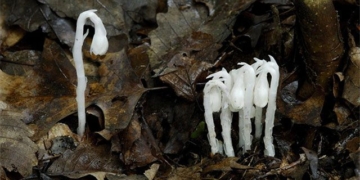American astrobiologists have identified the most common form of life that we might find on exoplanets.
According to Sci-News, a study from Cornell University and the University of Minnesota indicates that a potentially common form of extraterrestrial life is a group of microorganisms also present on Earth: purple bacteria.
Instead of being green, many bacteria on Earth contain purple pigments, and the purple world they dominate would generate a distinctive signal detectable through spectroscopy.

The mysterious purple color appearing on exoplanets might be life, similar to how green covers the continents of Earth – (AI graphic).
If a group of aliens possessed telescopes as powerful as those on Earth, they could detect this life signal.
This means that if we want to find a planet with life among the 5,500 exoplanets – that is, planets belonging to other star systems – identified by telescopes, we need to look for signs of purple bacteria in their spectra.
Dr. Lígia Fonseca Coelho from the Carl Sagan Institute at Cornell University stated: “Purple bacteria can thrive in a variety of conditions, making them one of the main candidates for life, potentially dominating many different worlds.”
Additionally, Dr. Lisa Kaltenegger, Director of the Carl Sagan Institute, emphasized the need to create a database of potential life signs to ensure that telescopes do not miss them, especially forms of life that may differ somewhat from those we see on Earth.
To identify the most likely type of life inhabiting exoplanets, the authors collected and cultured samples from over 20 types of sulfur purple bacteria, which do not contain sulfur and can be found in various environments.
These samples were taken from shallow waters, coastlines, and wetlands to deep-sea hydrothermal vents.
What is collectively known as purple bacteria actually comes in various colors including yellow, orange, brown, and red, due to a combination of purple and other pigments.
These purple bacteria thrive on lower-energy red or infrared light by using a simpler photosynthesis system than that of chlorophyll found in cyanobacteria and most plants on Earth.
These purple bacteria may have dominated primordial Earth before organisms evolved to photosynthesize as they do today.
Moreover, they are particularly suited to the mysterious red light of red dwarf stars, which are the most common type of star in the Milky Way galaxy that includes Earth.
Furthermore, simulations based on Earth’s own history show that they have persistently existed through the periods when our planet was an ocean world, a glacial sphere, and even in theoretical scenarios where Earth orbits a cooler star.
This suggests that these purple extraterrestrial organisms have many opportunities to proliferate on the 5,500 planets known to humanity.
This intriguing analysis was recently published in the scientific journal Monthly Notices of the Royal Astronomical Society.





















































